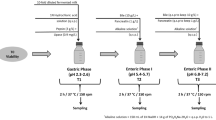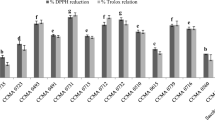Abstract
To evaluate the commercial potential of new microbial feed additive, Issatchenkia orientalis Y266 and Bacillus subtilis B266 from commercial fermented rice bran were tested for their tolerance or resistance to pH, bile, oxgall, and temperature. It was found that the strains grew very well up to pH 3.0 and resistant to relatively high concentrations of bile salt and oxgall. I. orientalis and B. subtilis are extremely tolerant in range of 70–90°C in solid medium. B. subtilis B266 also has excellent tolerant property up to 90°C in liquid medium. The health indexes (the microflora in the small intestines and the antibody titer to Newcastle disease virus) of chicks were significantly improved in the fermented rice bran with these strains (0.25% addition to diet) in comparison with the Avilamycin (20 mg/kg diet)-fed group (p < 0.05). The fermented rice bran-fed group showed a better microbial flora in the small intestines. Accordingly, it would appear that the fermented rice bran with these strains may be a potential candidate for an alternative microbial feed additive.



Similar content being viewed by others
References
Kamphues, J. (1999). Berliner und MuÉnchener TieraÉrztliche, 112, 370–379.
Joshi, V. K., Gupta, K., Devrajan, A., Lal, B. B., & Arya, S. P. (2000). Journal of Food Science and Technology, 37, 609–612.
Saha, S. K., Senani, S., Padhi, M. K., Shome, B. R., Shome, R., & Ahlawat, S. P. S. (1999). Current Science, 77, 696–697.
Kung, L. (1998). In S. Muirhead (Ed.), Direct-fed microbial, enzyme & forage additive compendium, vol.4: Direct-fed microbial and enzyme feed additives pp. 15–19. Minnesota, USA: Miller.
Martin, S. A., & Nisbet, D. J. (1992). Journal of Dairy Science, 75, 1736–1744.
Koh, J. H., Yu, K. W., & Suh, H. J. (2002). Letters in Applied Microbiology, 35, 47–51. doi:10.1046/j.1472-765X.2002.01131.x.
Reynolds, D. L. (1998). In S. Muirhead (Ed.), Direct-fed microbial, enzyme & forage additive compendium, vol 4: An overview of basic microbiology pp. 9–14. Minnesota, USA: Miller.
Yang, S. Y., Song, M. D., Kim, O. H., & Kim, C. W. (2001). Korean Journal Applied Microbiology and Biotechnology, 29, 110–114.
Kung, L., Kreck, E. M., Tung, R. S., Hession, A. O., Sheperd, A. C., Cohen, M. A., et al. (1997). Journal of Dairy Science, 80, 2045–2051.
Paek, N. S., Lee, Y. B., & Kim, Y. M. (2001). Korean Journal Applied Microbiology and Biotechnology, 1, 56–61.
Akita, T., & Kuwahara, A. (1987). Kochi Joshi Daigaku Kiyo Shizen Kagakuhen, 35, 45–58.
Kim, K. M., Yu, K. W., Kang, D. H., Koh, J. H., Hong, B. S., & Suh, H. J. (2001). Bioscience, Biotechnology, and Biochemistry, 65, 2294–2296. doi:10.1271/bbb.65.2294.
Agarwal, N., Kamra, D. N., Chaudhary, L. C., Sahoo, A., & Pathak, N. N. (2000). Letters in Applied Microbiology, 31, 220–27310. doi:10.1046/j.1472-765x.2000.00826.x.
Cho, M. K., Kim, C. H., Lee, T. K., & Kim, K. Y. (2000). Korean Journal Applied Microbiology and Biotechnology, 28, 279–284.
Jones, C. D., & Thomas, C. N. (1987). In T. P. Lyons (Ed.), Biotechnology in feed industry: The maintenance of strain specificity and bile tolerance when producing stable bacteria pp. 157–166. Kentucky: Alltech.
Havenaar, R., Brink, B. T., & Huis, J. H. J. (1992). In R. Fuller (Ed.), Probiotics, the scientific basis: Int’l veld selection of strains for probiotic use pp. 209–224. London, England: Chapman & Hall.
Lee, J. H., Lim, Y. B., Koh, J. H., Baig, S. Y., & Shin, H. T. (2002). Journal of Microbiology and Biotechnology, 12, 162–165.
KFIC (1985). Nutritional requirement and breeding system for domestic animals in Korea. Seoul, Korea: Dongsin.
Watkins, K. L., Shryock, T. R., Dearth, R. N., & Saif, Y. M. (1997). Veterinary Microbiology, 54, 195–200. doi:10.1016/S0378-1135(96)01276-X.
Beard, C. W. (1980). In S. B. Hitchner, C. H. Domermuth, H. G. Purchase, & J. E. Williams (Eds.), Isolation and identification of avian pathogens pp. 129–135. Pennsylvania, USA: American Association of Avian Pathology.
Ahlam, A. W. S. S. (2005). Ph. D. Thesis. Pakistan: University of the Punjab.
Gilliland, S. E., Stahly, T. E., & Bush, L. J. (1984). Journal of Dairy Science, 67, 3045–3051.
Vervaeke, I. J., Van Nevel, C. J., Decuypere, J. A., & Van Assche, P. F. (1973). The Journal of Applied Bacteriology, 36, 397–405.
Pinchuk, I. V., Bressollier, P., Verneuil, B., Fenet, B., Sorokulova, I. B., Megraud, F., et al. (2001). Antimicrobial Agents and Chemotherapy, 45, 3156–3161. doi:10.1128/AAC.45.11.3156-3161.2001.
Zheng, G., & Slavik, M. F. (1999). Letters in Applied Microbiology, 28, 363–367. doi:10.1046/j.1365-2672.1999.00545.x.
Cladera-Olivera, F., Caron, G. R., & Brandelli, A. (2004). Letters in Applied Microbiology, 38, 251–256. doi:10.1111/j.1472-765X.2004.01478.x.
Subramanian, P., & Shankar, P. A. (1983). Journal of Food Science and Technology, 20, 181–183.
Borregaard, E., & Arneborg, N. (1998). Interactions between Lactococcus lactis subs. lactis and Issatchenkia orientalis at milk fermentation. Food Technology and Biotechnology, 36, 75–78.
Butaye, P., van Damme, K., Devriese, L. A., van Damme, L., Baele, M., Lauwers, S., et al. (2000). International Journal of Food Microbiology, 54, 181–187. doi:10.1016/S0168-1605(99)00198-1.
Fujiwaru, S., Hashiba, H., Hirota, T., & Forstner, J. F. (2001). International Journal of Food Microbiology, 67, 97–106. doi:10.1016/S0168-1605(01)00432-9.
Kwon, N. H., Kim, S. H., Bae, W. K., Kim, J. K., & Lim, J. Y. (2001). Journal of Hygiene Safety, 16, 264–273.
Barrow, P. A. (1992). In R. Fuller (Ed.), Probiotics, the Scientific basis: Probiotics for chickens pp. 225–257. London: Chapman and Hall.
Kato, T., & Owen, R. L. (1994). In P. L. Ogra, J. Mestecky, M. E. Lamm, W. Strober, J. R. McGhee, & J. Bienenstock (Eds.), Handbook of mucosal immunology: Structure and function of intestinal mucosal epithelium pp. 11–26. San Diego, USA: Academic.
Alexander, D. J. (1997). In B. W. Calneck (Ed.), Diseases of poultry, 10th edition: Newcastle disease and other avian Paramyxoviridae infections p. 54125. Iowa, USA: Iowa State University Press.
Heremans, J. F. (1974). In F. Milgrom, & E. Neter (Eds.), The immune system and infectious diseases: Proceedings. 4th International Convocation Immunology: The secretary immune system. A critical appraisal pp. 376–385. Buffalo, N.Y. June 1974.
Mueller, A. P., Sato, K., & Glick, B. (1971). Cellular immunology, 2, 140–152. doi:10.1016/0008-8749(71)90033-5.
Author information
Authors and Affiliations
Corresponding author
Rights and permissions
About this article
Cite this article
Koh, J.H., Suh, H.J. Biological Activities of Thermo-tolerant Microbes from Fermented Rice Bran as an Alternative Microbial Feed Additive. Appl Biochem Biotechnol 157, 420–430 (2009). https://doi.org/10.1007/s12010-008-8311-3
Received:
Accepted:
Published:
Issue Date:
DOI: https://doi.org/10.1007/s12010-008-8311-3




